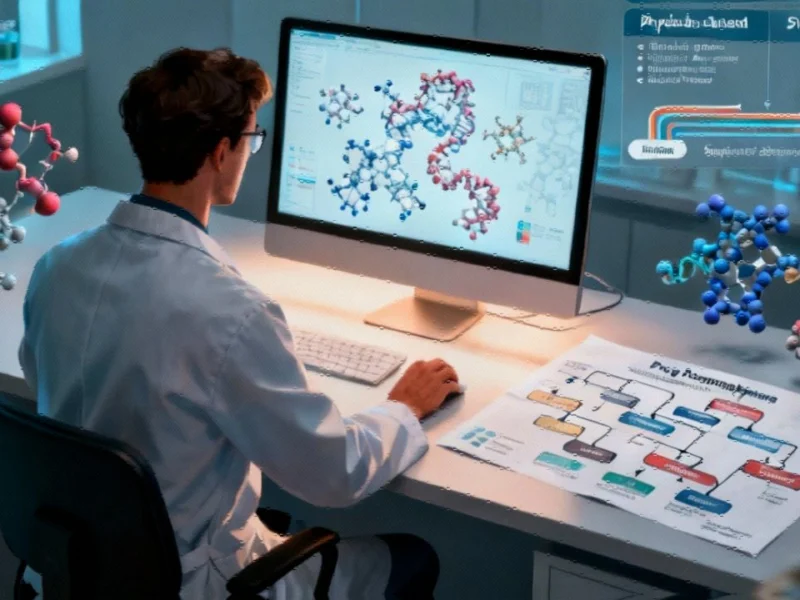Bridging Machine Learning and Physical Laws in Pharmaceutical Research
In the rapidly evolving field of computational drug discovery, researchers are confronting a fundamental challenge: artificial intelligence models often generate predictions that, while statistically plausible, violate basic principles of physics. This limitation becomes particularly problematic when these systems attempt to predict molecular interactions for compounds significantly different from their training data.
Caltech’s Anima Anandkumar and her research team have developed a groundbreaking solution to this problem. Their new machine learning framework, NucleusDiff, integrates fundamental physical constraints directly into the AI training process, resulting in dramatically more accurate and physically plausible predictions for drug-target interactions.
The Physical Reality Gap in AI Drug Design
Traditional drug discovery AI models, including notable systems like AlphaFold, have demonstrated remarkable capabilities in predicting molecular structures and interactions. However, these systems frequently produce “unphysical” results—configurations that cannot exist according to the laws of physics—particularly when working with novel molecular structures outside their training parameters.
“With machine learning, the model is already learning many of the aspects of what makes for good binding, and now we throw in some simple physics to make sure we rule out all the unphysical things,” Anandkumar explains in her Proceedings of the National Academy of Sciences publication.
NucleusDiff: A Physics-Informed Architecture
The innovation behind NucleusDiff lies in its elegant incorporation of physical constraints without overwhelming computational resources. Rather than tracking distances between every atomic pair—a prohibitively expensive calculation—the model estimates a molecular manifold that represents the probable distribution of atoms and electrons.
This approach establishes key anchoring points to monitor, ensuring atoms maintain appropriate distances and accounting for repellant forces that prevent atomic collisions. “Surprisingly, without these constraints, all these AI models tend to predict that there is collision, that the atoms come too close,” Anandkumar notes. “By adding simple physics, we increased the model’s accuracy.”
Validation and Performance Metrics
The research team trained NucleusDiff using the CrossDocked2020 dataset, containing approximately 100,000 protein-ligand binding complexes. When tested on 100 complexes, the model significantly outperformed state-of-the-art alternatives in binding affinity predictions while reducing atomic collisions to nearly zero.
Further validation came through testing on the COVID-19 therapeutic target 3CL protease, a molecule absent from the training data. NucleusDiff demonstrated up to two-thirds reduction in atomic collisions compared to leading models while maintaining superior accuracy in binding affinity predictions.
Broader Implications for Scientific AI
This research represents a significant step in the AI4Science initiative, which seeks to integrate physical principles into data-driven AI models across multiple domains. As Anandkumar observes, “If we rely purely on training data, we do not expect machine learning to work well on examples that are significantly different from the training data.”
The approach addresses a critical limitation in current machine learning applications for scientific discovery, where models typically perform well only within the distribution of their training examples. For drug discovery, where researchers specifically seek novel molecular configurations, this constraint has been particularly limiting.
Future Directions and Industry Impact
The success of NucleusDiff suggests a paradigm shift in how computational models might be developed for scientific applications. By embedding physical laws directly into learning architectures, researchers can create systems that generalize more effectively to novel scenarios.
This physics-enhanced approach could accelerate drug discovery pipelines while reducing computational costs associated with filtering implausible molecular configurations. As these computational methodologies continue to evolve, they may transform how pharmaceutical companies approach early-stage drug development.
The integration of physical constraints also addresses growing concerns about AI reliability in scientific contexts. “We see a lot of machine learning fail in coming up with accurate results on new examples that are different from training data,” Anandkumar states, “but by incorporating physics, we can make machine learning more trustworthy and also work much better.”
Connecting to Broader Computational Trends
This breakthrough in computational drug discovery aligns with broader industry developments in trustworthy AI systems. As computational models become increasingly integral to scientific discovery, ensuring their physical plausibility and reliability becomes paramount.
The methodology demonstrated by NucleusDiff may find applications beyond pharmaceutical research, potentially influencing related innovations in materials science, climate modeling, and engineering simulation. By bridging the gap between data-driven learning and physical reality, researchers are creating AI systems that not only predict but understand.
As computational power continues to grow and physical modeling becomes more sophisticated, we can expect to see further integration of domain knowledge into machine learning frameworks, potentially revolutionizing how we approach complex scientific challenges across multiple disciplines.
This article aggregates information from publicly available sources. All trademarks and copyrights belong to their respective owners.
Note: Featured image is for illustrative purposes only and does not represent any specific product, service, or entity mentioned in this article.



